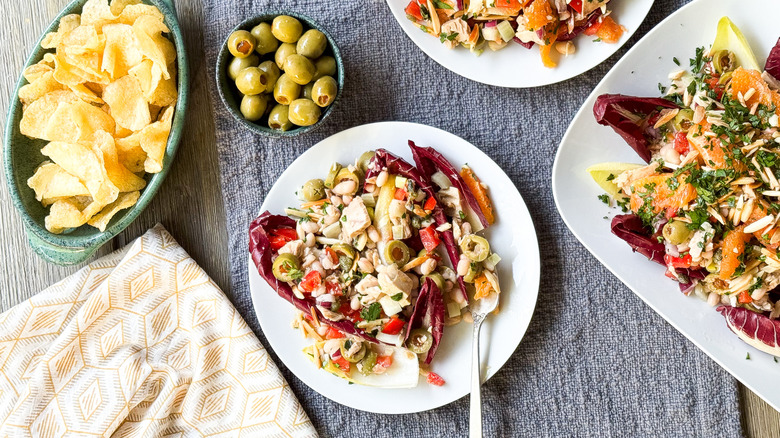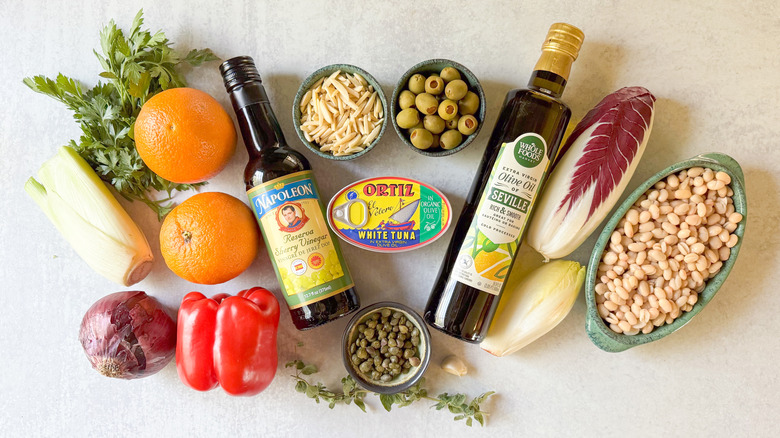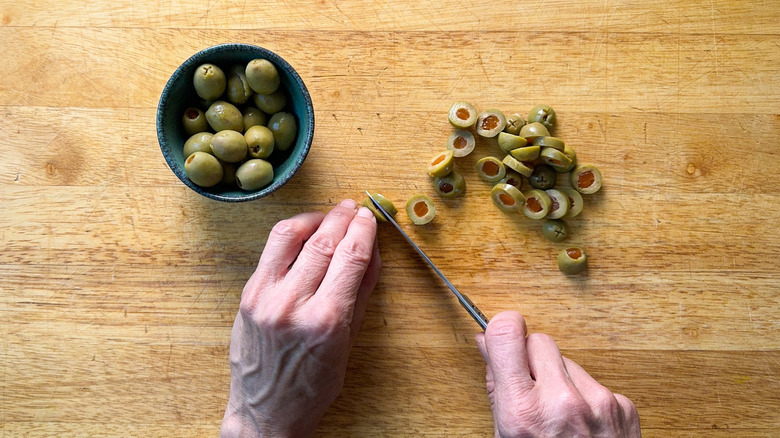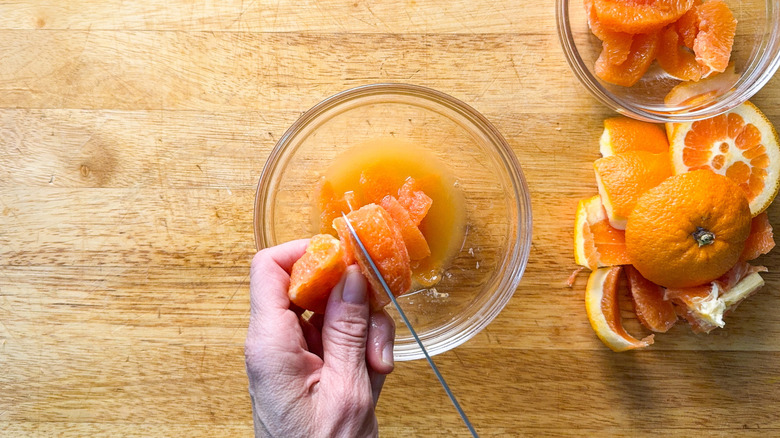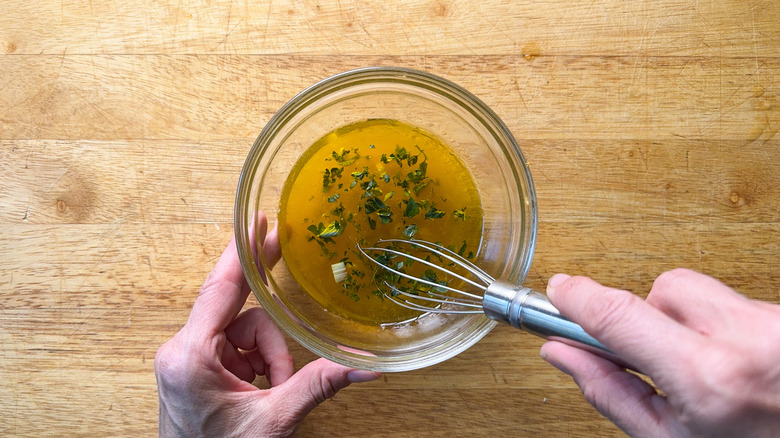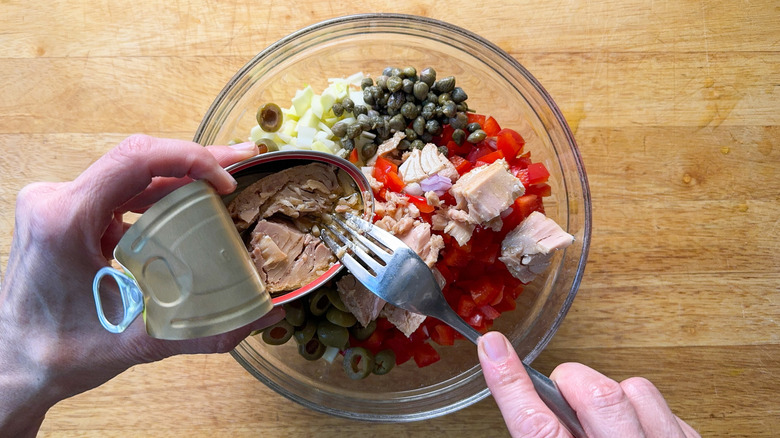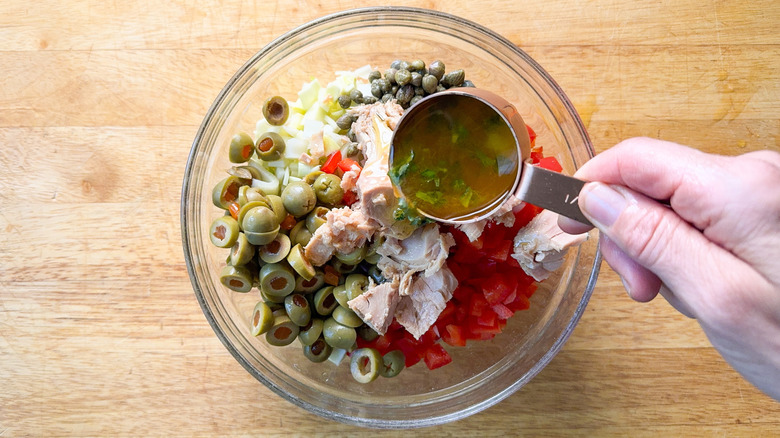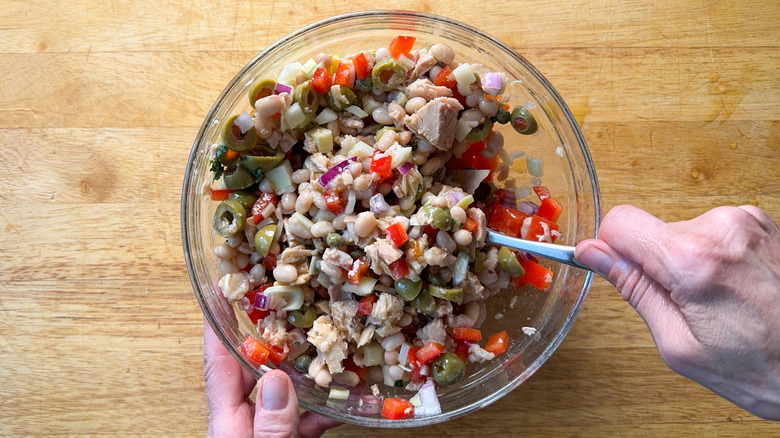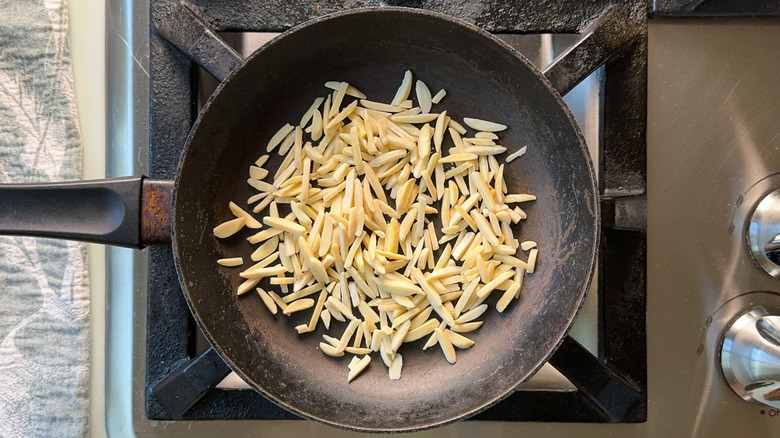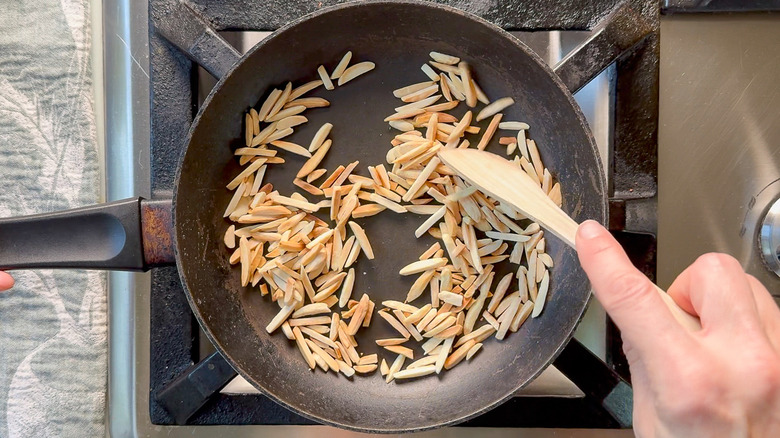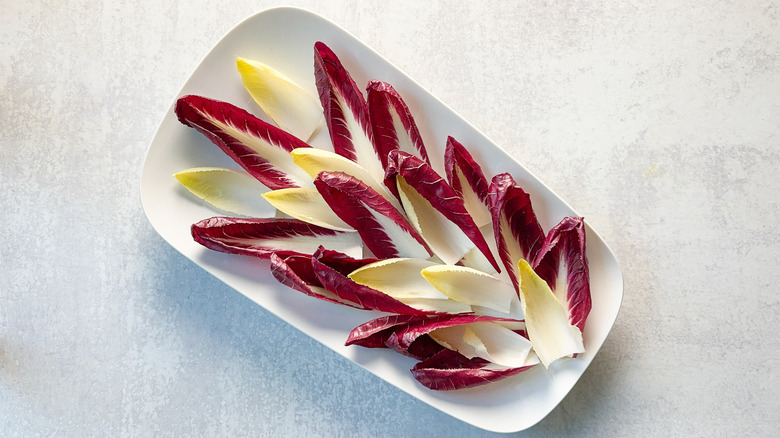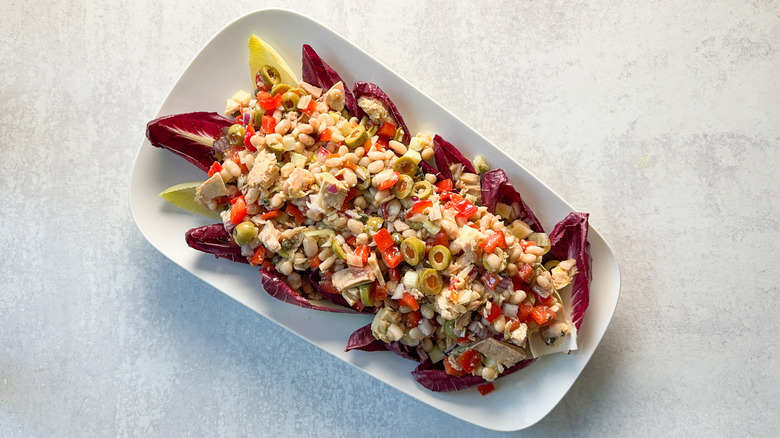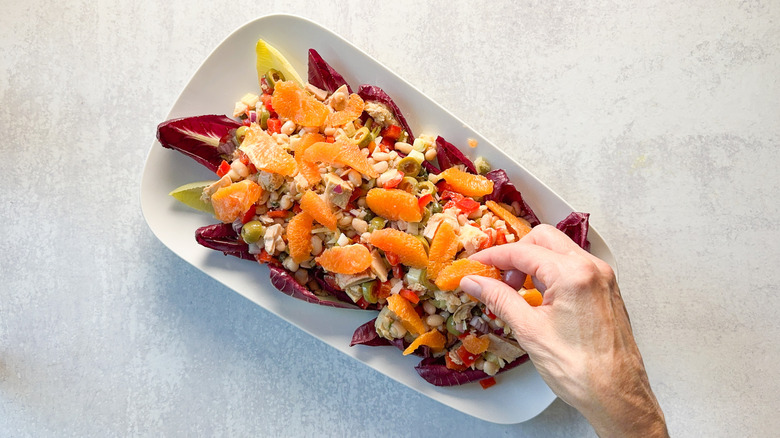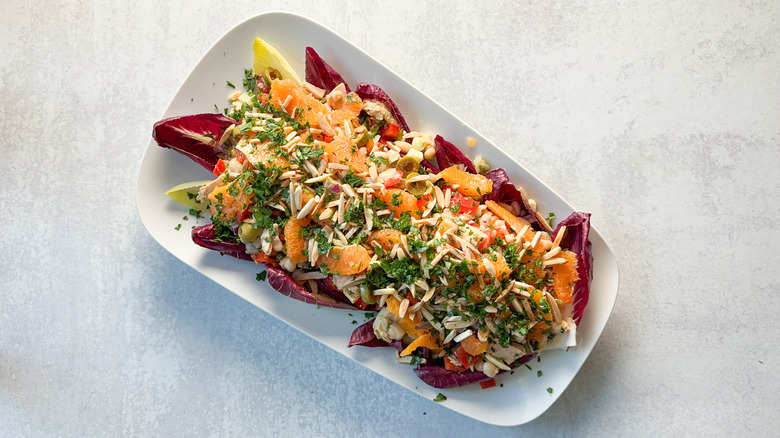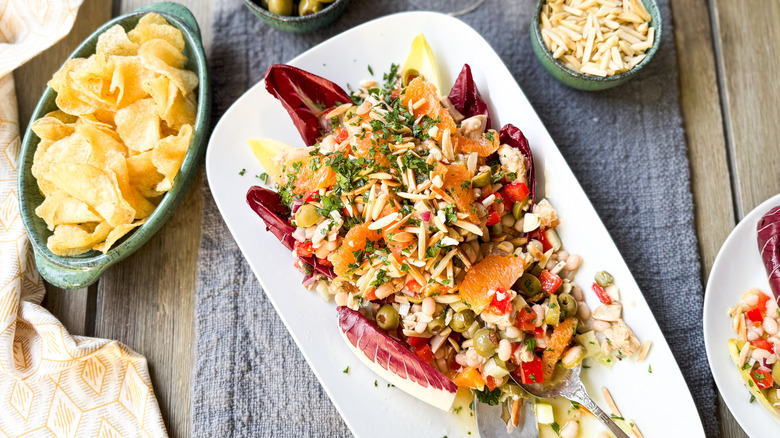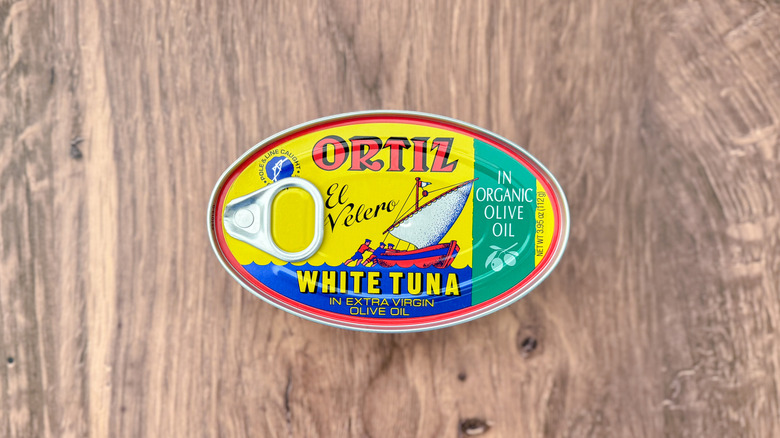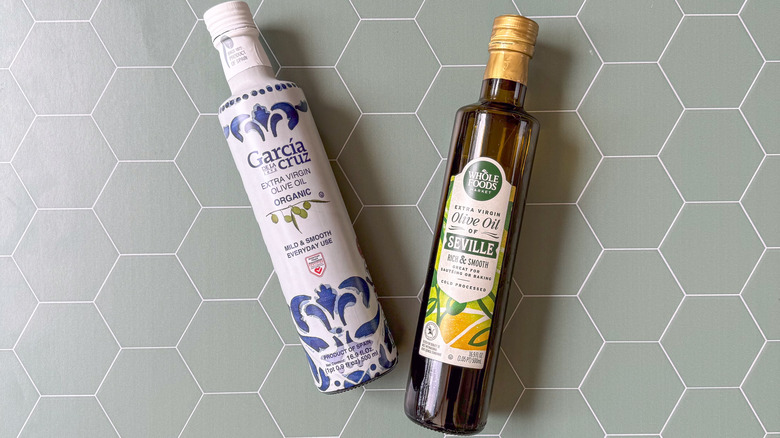Spanish-Inspired Tuna Salad With White Beans And Oranges Recipe
If the words "tuna salad" conjure unfavorable images of mayonnaise-laden and monochromatic canned fish, this Spanish-inspired tuna salad with white beans and oranges will give you a whole new appreciation for the dish. Recipe developer Julie Kinnaird shares her interpretation of tuna salads that she tasted throughout Spain. Kinnaird says that in Spain, tuna salad is often served alongside grilled fish and roasted potatoes, but it can also be the star of the meal with a side of crusty bread. Kinnaird especially enjoyed a Valencia-style salad she had in Madrid, which was garnished with plenty of juicy fresh orange segments.
Spanish tuna salads typically feature white tuna packed in olive oil, a variety of olives, onion, greens, cooked beans, boiled eggs, and potatoes. Kinnaird's version features all of her favorite components, using pimento-stuffed olives, fresh fennel, red peppers, onion, capers, crunchy toasted almonds, creamy white beans, and the delightful, juicy oranges. She makes a salad dressing with the juice of the oranges, good-quality Spanish olive oil, sherry wine vinegar for a signature taste, and fresh oregano. The salad is full of color and flavor, and it looks stunning when it's served on a platter.
Gather the ingredients for Spanish-inspired tuna salad with white beans and oranges
For this recipe, Kinnaird uses her favorite canned Spanish tuna packed in olive oil, which is produced by Ortiz. Any good-quality white tuna packed in olive oil would be a suitable substitute. The tuna is tossed with chopped red onion, sweet red bell pepper, fresh fennel bulb, sliced Manzanilla olives with pimentos tucked inside, and capers with a little of their brine. Canned white navy beans (or other small white bean varieties) add a creamy texture to the salad — just be sure to rinse them first.
For the salad dressing, you will want to use a good-quality Spanish extra-virgin olive oil (for authenticity), sherry vinegar, chopped garlic, and fresh oregano. Juice from Valencia oranges (or other similar varieties) is collected to add to the dressing when removing the segments from the peel and membranes. Because the olives and capers with brine are quite salty, you won't need additional salt for this recipe, unless you have a personal preference. The salad is finished with toasted slivered almonds and fresh chopped Italian parsley, and it's served on a bed of red and white Belgian endive leaves.
Step 1: Slice the olives
Slice the olives into rounds.
Step 2: Cut the ends off of the oranges
Cut the ends from both oranges to expose the flesh.
Step 3: Cut the peel away from the oranges
Stand the orange on one flat end on a cutting board and carefully cut the peel and pith away from the flesh.
Step 4: Release the orange segments from the membranes
Use a sharp knife to cut between the membranes and release the segments and juice into a bowl, squeezing out the extra juice from the membranes and peels. Transfer the segments to a separate bowl.
Step 5: Make the dressing
Whisk the olive oil, sherry vinegar, garlic, and oregano into the orange juice to make the dressing. Set aside.
Step 6: Combine the salad ingredients
In a large bowl, combine the sliced olives, beans, fennel, capers, caper brine, red pepper, and onion. Add the tuna and oil from each can.
Step 7: Add the dressing
Add ⅓ cup of the dressing to the tuna mixture.
Step 8: Toss the salad
Toss gently to combine and set aside.
Step 9: Add the almonds to a skillet
Add the almonds to a small skillet over medium heat.
Step 10: Toast the almonds
Toast the almonds, stirring frequently, until golden brown (about 5 minutes). Remove from the skillet to cool.
Step 11: Arrange the endive leaves on a platter
To assemble the salad, arrange the endive leaves on a large platter or shallow serving bowl.
Step 12: Add the tuna salad
Mound the tuna salad mixture on top of the endive.
Step 13: Add the orange segments
Add the reserved orange segments.
Step 14: Add the almonds and parsley
Sprinkle on the toasted almonds and chopped parsley.
Step 15: Drizzle on the remaining dressing
Finish by drizzling on the remaining dressing.
Step 16: Serve the Spanish-inspired tuna salad with white beans and oranges
Serve the Spanish-inspired tuna salad with white beans and oranges immediately.
Spanish-Inspired Tuna Salad With White Beans and Oranges Recipe
This Spanish-inspired tuna salad is bright and fresh. A blend of citrus, herbs, beans, and aromatic vegetables give this party-perfect dish its flavor.
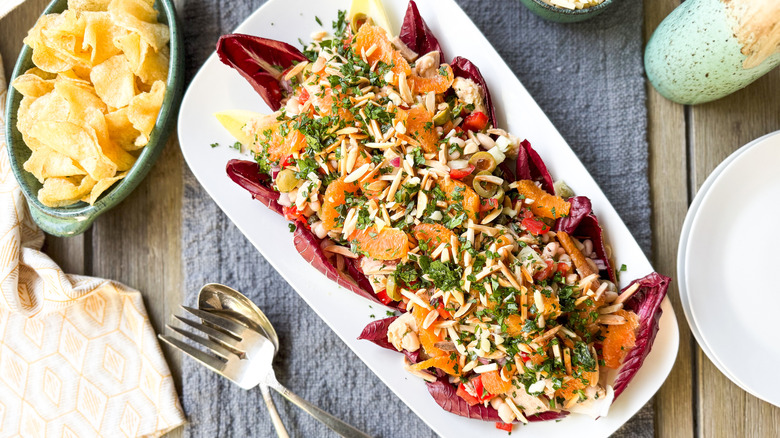
Ingredients
- ½ cup pimiento-stuffed Spanish olives, drained
- 2 Valencia or navel oranges
- 3 tablespoons Spanish olive oil
- 2 tablespoons sherry vinegar
- 1 small clove garlic, minced
- 1 tablespoon chopped fresh oregano
- 1 (15-ounce) can small white beans (navy or great northern), drained and rinsed
- 1 small bulb fennel, stem and green stalks removed, chopped
- 2 tablespoons capers
- 1 tablespoon caper brine
- 1 small red bell pepper, stem, ribs and seeds removed, chopped
- ¼ cup chopped red onion
- 2 (4-ounce) cans Spanish tuna in olive oil
- ½ cup slivered raw almonds
- ¼ cup chopped fresh Italian parsley
- 2 small heads Belgian endive (1 red, 1 white), trimmed and leaves separated
Directions
- Slice the olives into rounds.
- Cut the ends from both oranges to expose the flesh.
- Stand the orange on one flat end on a cutting board and carefully cut the peel and pith away from the flesh.
- Use a sharp knife to cut between the membranes and release the segments and juice into a bowl, squeezing out the extra juice from the membranes and peels. Transfer the segments to a separate bowl.
- Whisk the olive oil, sherry vinegar, garlic, and oregano into the orange juice to make the dressing. Set aside.
- In a large bowl, combine the sliced olives, beans, fennel, capers, caper brine, red pepper, and onion. Add the tuna and oil from each can.
- Add ⅓ cup of the dressing to the tuna mixture.
- Toss gently to combine and set aside.
- Add the almonds to a small skillet over medium heat.
- Toast the almonds, stirring frequently, until golden brown (about 5 minutes). Remove from the skillet to cool.
- To assemble the salad, arrange the endive leaves on a large platter or shallow serving bowl.
- Mound the tuna salad mixture on top of the endive.
- Add the reserved orange segments.
- Sprinkle on the toasted almonds and chopped parsley.
- Finish by drizzling on the remaining dressing.
- Serve the Spanish-inspired tuna salad with white beans and oranges immediately.
What type of tuna is best for a tuna salad?
If you have shopped for tuna recently, you may have noticed that the canned fish aisle at the grocery store is not what it used to be! There seems to be an overwhelming number of tuna varieties and brands to choose from. There's oil-packed, water-packed, salted, marinated, or sodium-free. There is also the question of which type of tuna is the most eco-friendly.
Albacore, or "white," tuna is a preferable choice for making tuna salad in terms of flavor, nutrition, and ethics. Albacore is not overly fishy tasting and has a firm texture that won't become mushy when you mix it. Albacore also has more omega-3 fatty acids than others in the tuna family. It is a sustainable option that is not in danger of being over-fished. Kinnaird says that she has been eating Ortiz olive oil-packed tuna for years because of its superior quality and flavor. Conservas Ortiz has canning origins in Spain from 1891, and the company was officially created in 1956. Ortiz has historically had a commitment to quality and traditional fishing methods, and all of the tuna is caught by hand. The white tuna Ortiz uses in its products is Bonito Del Norte, which is considered to be one of the best tunas in Spain.
What's the difference between regular and Spanish olive oil?
When most people think of olive oil, they think of Italy, which is famous for using the oil in all facets of cooking. Yet, surprisingly, Spain takes the top honors. The country produced over 5.9 million tons of olive oil in 2023, which was almost double Italy's production! Olives have been a part of Spanish cuisine for thousands of years, and the country has been producing olive oil since the time of the Roman Empire. Spain's climate is optimal for olive production, and it is home to around 350 million olive trees. Andalusia in southern Spain produces more olive oil than anywhere else on the planet.
So, what makes Spanish olive oil different from other countries'? Spanish olive oil is very high quality and often has a fruitier taste than other varieties due to the ideal growing conditions. Spanish olive oil will vary from region to region in taste and color, depending on which type of olives are selected. In Andalusia, hojiblanca olives are used, which give the oil a grassy taste. In Central Spain, Cornicabra olives are more common and give the oil a more bitter edge. Overall, you can rely on Spanish olive oil for high marks in quality and intensity of flavor.
